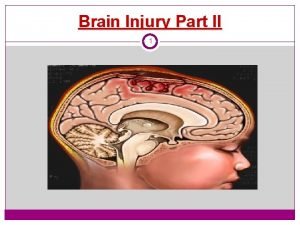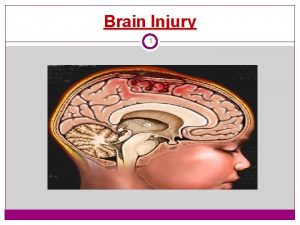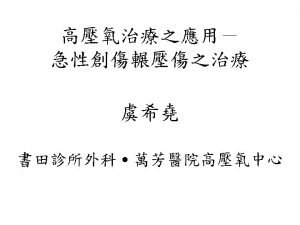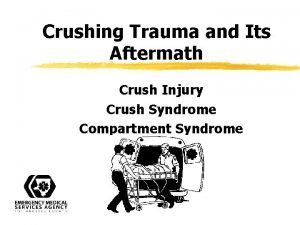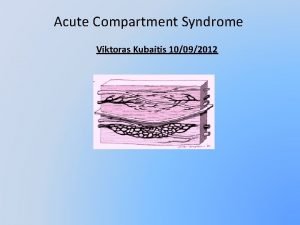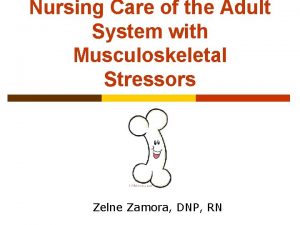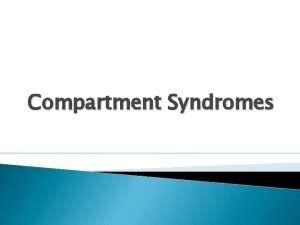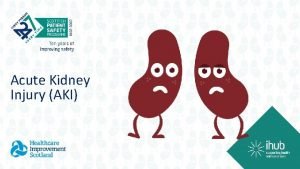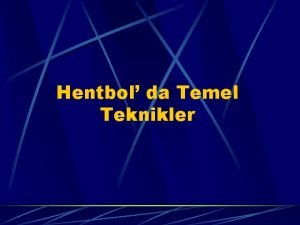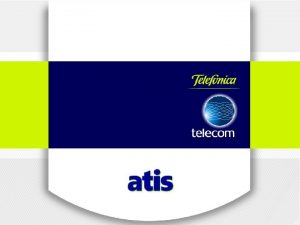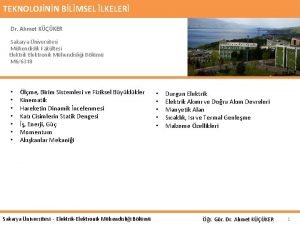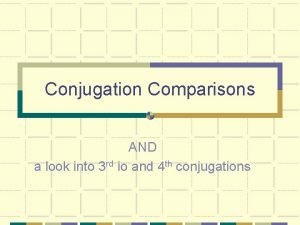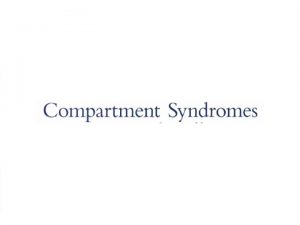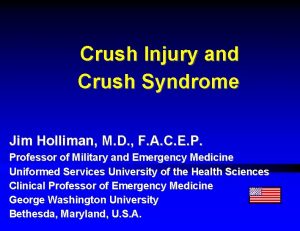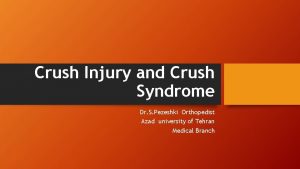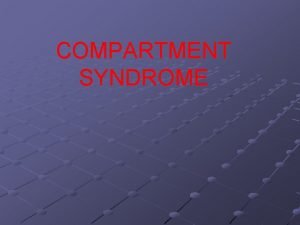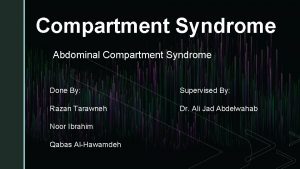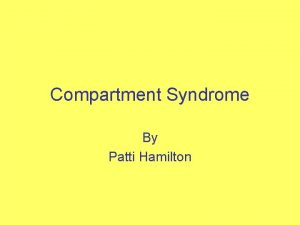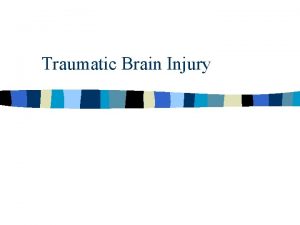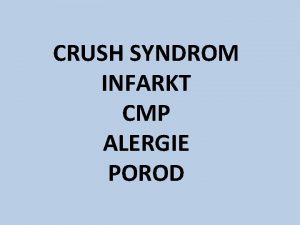Crush Injury Compartment Syndrome Acute Traumatic Ischemias ATIs
















- Slides: 16


名詞說明 • Crush Injury 壓挫傷 • Compartment Syndrome 腔室症候群 • Acute Traumatic Ischemias (ATIs) 創傷型急性缺血 • Acute Traumatic Peripheral Ischemias (ATPIs) 創傷型急性四肢缺血









四肢 Crush Injuries何時輔以 HBO 2 ? ~ 用 Gustilo Open Fracture Classification System 來評估 Type Mechanism Expected Outcome HBO 2 Indications I Small (< 1 cm) laceration from inside to outside Usually not different from a closed fracture None II Large laceration, but minimal soft tissue damage Usually no different from a closed fracture Compromised hosts such as diabetics, advanced peripheral vascular disease, collagen vascular diseases, etc. , where concern is raised about primary healing of flaps III Crush tissue: A. Infections and/or nonunion rates < 10 % B. About 50% incidence of complications (infection, nonunion) C. About 50% incidence of complications (infections, nonunion) A. Same as for type II fractures A. Sufficient soft tissue to close wound (primary and delayed) B. Flaps or grafts required to obtain soft tissue coverage C. Major (macrovascular) vessel injury B. All injuries C. All injuries

四肢 Crush Injuries何時輔以 HBO 2 ? ~ 用 Mangled Extremity Severity Score (MESS) 來評估 A. Skeletal/soft tissue injury Low energy (stab, simple fracture; low velocity gun shot wound) Medium energy (open or multiple fractures, dislocations) High energy (close-range shot gun or high velocity GSW, crush injury) Very high energy (above plus gross contamination, soft tissue avulsion) Points 1 2 3 4 B. Limb ischemia Pulse reduced or absent, but perfusion present Pulselessness, paresthesias, diminished capillary refill 2* Cool, paralyzed, insensate, numb 3* *Double score if ischemia time > 6 hours 1* 2* 3* C. Shock Systolic BP always > 90 mm. Hg Hypotension transiently Persistent hypotension 0 1 2 D. Age < 30 30 -50 > 50 0 1 2 • MESS=A+B+C+D • Johansen et al 建議當 MESS 7 分以上時應行截肢。 • MESS 在 3~8分時,依以下原則決定HBO 2輔助治療。 MESS (甲) 7 (possibly 8) (乙) 5, 6 (丙) 3, 4 HB 02 Indications (甲) 分數主要來自B, C, D三項的健常患者。 (乙) 糖尿病、周邊動脈硬化、凝血或膠原蛋白功能異常、、、等不 良癒傷因子,輕或中度者。 (丙)糖尿病、周邊動脈硬化、凝血或膠原蛋白功能異常、、、等不良 癒傷因子,重度者。

評估骨骼肌群 Compartment Syndrome I. 臨床症狀: 1. Severe pain in muscle compartment 2. Marked increase in pain with passive stretch of muscles in the compartment 3. Marked swelling of the compartment 4. Marked tenseness of the muscle compartment 5. Neuropathy, myelopathy, and/or encephalopathy II. 骨骼肌腔室壓力測量: 1. Greater than 40 mm. Hg in the uncomprotnised host 2. Rising serial compartment pressure measurements as values approach 35 mm. Hg 3. 30 -40 mm. Hg in mildly compromised host (diabetic, peripheral vascular disease, collagen vascular disease, etc. ) 4. 20 -30 mm. Hg in hypotensive patients where systolic blood pressure is 33 to 50% lower than is expected. 下二項任一時建議輔以HBO 2: • 在 I. 臨床症狀 內有3項以上。 • 在 II. 骨骼肌腔室壓力測量 內有任何一項。



ADJUNCTIVE HYPERBARIC OXYGEN TREATMENT FOR 8 PATIENTS WITH CRUSH SYNDROME IN DEVASTATING EARTHQUAKE. SY Yu. Wound Care and Hyperbaric Medicine Center, Department of Surgery, Changhua Christian Hospital, Changhua City, Taiwan 500 BACKGROUND: Hyperbaric oxygen therapy (HBOT) has been reported as an useful adjunct for the management of crush injuries. A devastating earthquake scaled 7. 3 hit central Taiwan in the early morning on Sep. 21, 1999, and aftershocks scaled between 5 to 6 persisted for months. Changhua Christian Hospital, the nearest medical center to the quake region, has received more than 2000 emergent trasferral during the disaster. CASE REPORT: There were 8 severely injured patients managed with both traditional treatments and adjunctive hyperbaric oxygen treatment. Two of them received amputation finally. An 8 -year-old girl with severe crush over both lower limbs lost her left leg by a below-knee amputation because of irreversible gangrenous change and uncontrolled sepis. Hypoxia of her right leg was reversed by fasciotomy and intensive HBOT. A 6 -year-old girl with duodenal perforation and totally crushed left lower limb underwent emergent laparotomy, fasciotomy and early HBOT. An inevitable transmetatarsal amputation was done for her to remove the gangrenous part of foot. A back hoes tilted over a 25 -year-old young man resulting in an open tibial fracture and severe crush, which was corrected by repeated operations and HBOT. Compartment syndrome also developed in another 4 patients, and relieved with no or mild neurologic deficit after 5 to 20 dives of HBOT. A 6 -year-old girl with cardiac tamponade underwent emergent cardiac ventricle repair and depended on ventilator for pulmonary contussion postoperatively. The sternotomy wound was dehescenced and deeply infected, but healed well after repeated operations and 12 dives of HBOT. CONCLUSION: With the benefit of promoting wound healing, decreasing infection and shortening hospital day, these cases are to be presented to conclude that early adjunctive hyperbaric oxygen therapy plays an important role in the treatment of crush syndrome.
 Traumatic brain injury concept map
Traumatic brain injury concept map Halo effect csf
Halo effect csf Crush syndrome icd 10
Crush syndrome icd 10 Taiwan earthquake
Taiwan earthquake Crush syndrome
Crush syndrome Example of intentional injury
Example of intentional injury 7p compartment syndrome
7p compartment syndrome Skin traction definition
Skin traction definition Mobile wad of henry
Mobile wad of henry Skt aki
Skt aki Hentbolda top tutma
Hentbolda top tutma Düşerek atış
Düşerek atış Atis telefonica
Atis telefonica Düşey yukarı atış
Düşey yukarı atış Jason atis
Jason atis Example of a sexual propagation
Example of a sexual propagation Pono ponere latin conjugation
Pono ponere latin conjugation
